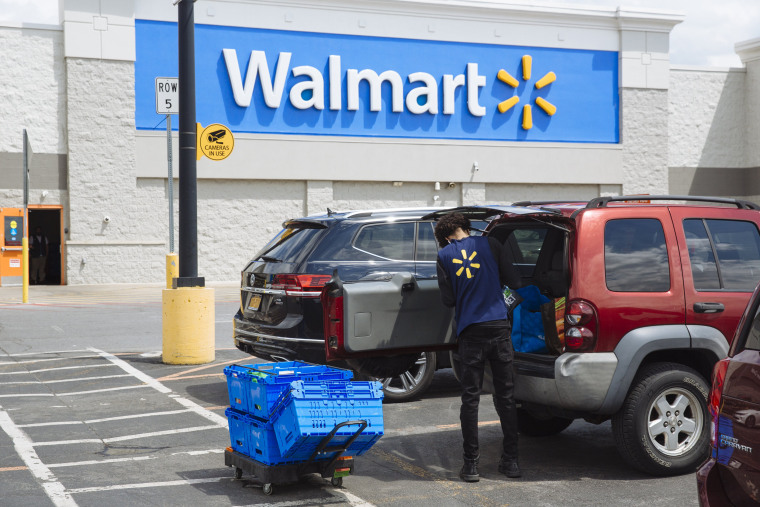Walmart is raising the stakes in its ongoing rivalry with e-commerce giant Amazon, launching a subscription service Tuesday that includes free shipping and gas discounts.
Walmart+ will offer members free grocery and household delivery and mobile checkout on store purchases, all for $98 a year. It will also offer a discount of up to 5 cents a gallon at Walmart and Murphy fuel stations, with Sam’s Club to be added at a later date. Non-members will continue to receive free shipping on most online orders over $35.
The launch is a dramatic pivot from the company’s notorious resistance to rolling out a loyalty program, which it has long said goes against its mantra to offer an ‘everyday low price’ to all customers.
However, the pressure has increased to ramp up online delivery efforts as Amazon continues its blistering pace of sales through its sophisticated delivery network. Amazon's second-quarter earnings report showed e-commerce sales surged by almost 50 percent, helping propel the retail behemoth to an all-time record $5.2 billion in profits.
But with roughly 150 million subscribers already tapped in to the Prime network, it is unclear if customers will pay for another subscription that doesn’t offer much of a competitive advantage over Prime, according to Walmart analysts and retail advisers.
“People are really rational, and people will pay for whatever gives them more value,” said Sucharita Kodali, a retail analyst with Forrester Research. “Absolutely they're in a position where people could be interested in purchasing an Amazon membership and Walmart membership — but the $100 has to offer something unique.”
At around $20 less than Amazon Prime, Walmart+ still lacks the bells and whistles of Prime, which has had a 15-year head start on the brick-and-mortar store behemoth, said Rupesh Parikh, Senior Equity Research Analyst at Oppenheimer.
Amazon Prime memberships include free, fast delivery on millions of products on its sprawling marketplace, along with video and music streaming. Amazon also reduced the cost of grocery delivery for Prime members last year and expanded its online grocery pickup capacity toward the beginning of the pandemic.
“In this current form, Walmart+ is not going to be super effective in outdoing Prime,” Parikh said. “It’s a good start but it's not enough at this point.”
Amazon’s draw for customers lies in its expanding assortment of products on a marketplace fueled by a legion of third-party sellers who compete on pricing and availability to give customers the best deal. It also has mastered the science of fast delivery — whereas Walmart scrapped its last attempt at a free shipping membership program in 2017.
Walmart’s marketplace has about 55,000 sellers while Amazon has about 2 million worldwide, according to e-commerce analysis firm Marketplace Pulse. For consumers, that means less availability on Walmart. For third-party sellers such as Massimo Gur, who sells baby shoes, clothes and household items on both Amazon and Walmart from his warehouse in West New York, New Jersey, it means 20 to 30 percent less in sales.
“The only reason why we started selling on Walmart is because we wanted to diversify,” Gur told NBC News. “But I don’t think there is a big competition there — I think Amazon is well ahead of the game.”
About 57 percent of shoppers in the U.S. said they had a Prime membership in 2019, according to Kantar Consulting’s ShopperScape. That means Walmart has to co-exist with Amazon in the same household, said Timothy Campbell, a principal analyst with Kantar.
“Amazon Prime has all these virtual benefits, whereas Walmart+ is primarily about online grocery,” he said. “More than that, all its advantages tend to leverage the store whether it’s gas discounts or Scan and Go.”
About 90 percent of people in the U.S. live within 10 miles of one of Walmart’s 2,700 stores, according to the company. Walmart overtook Amazon for the first time this year in grocery market share, holding about 30 percent of the online grocery market compared to Amazon at around 27 percent, according to an August report from TABS Analytics.
While some see Walmart+ as "the one subscription you’d get if you do online grocery," others tout Amazon Prime's benefits such as video streaming and voice ordering through Alexa.
“[Walmart+] is an online grocery play,” said Campbell. “This would be the one subscription you’d get if you do online grocery.”
Annalese Hribar, a stay-at-home mom of two children in Novelty, Ohio, has been a Prime member for four years. But she plans on also signing up for Walmart+ as soon as she can. Her husband works long hours, leaving her at home with her two-year old and three-year old with little time to make a grocery run. Whole Foods doesn’t provide grocery delivery to her area. But several Walmarts do.
“I can literally make more meals because I’ll have the ingredients available,” she said. “They have everything and the prices are nice.”
She’s planning on keeping both Amazon and Walmart subscriptions because she likes that Prime provides other benefits like video streaming and voice ordering through Alexa.
“It will be nice to have both on hand,” she said. “I need an even half and half where we can make the most out of each subscription.”
